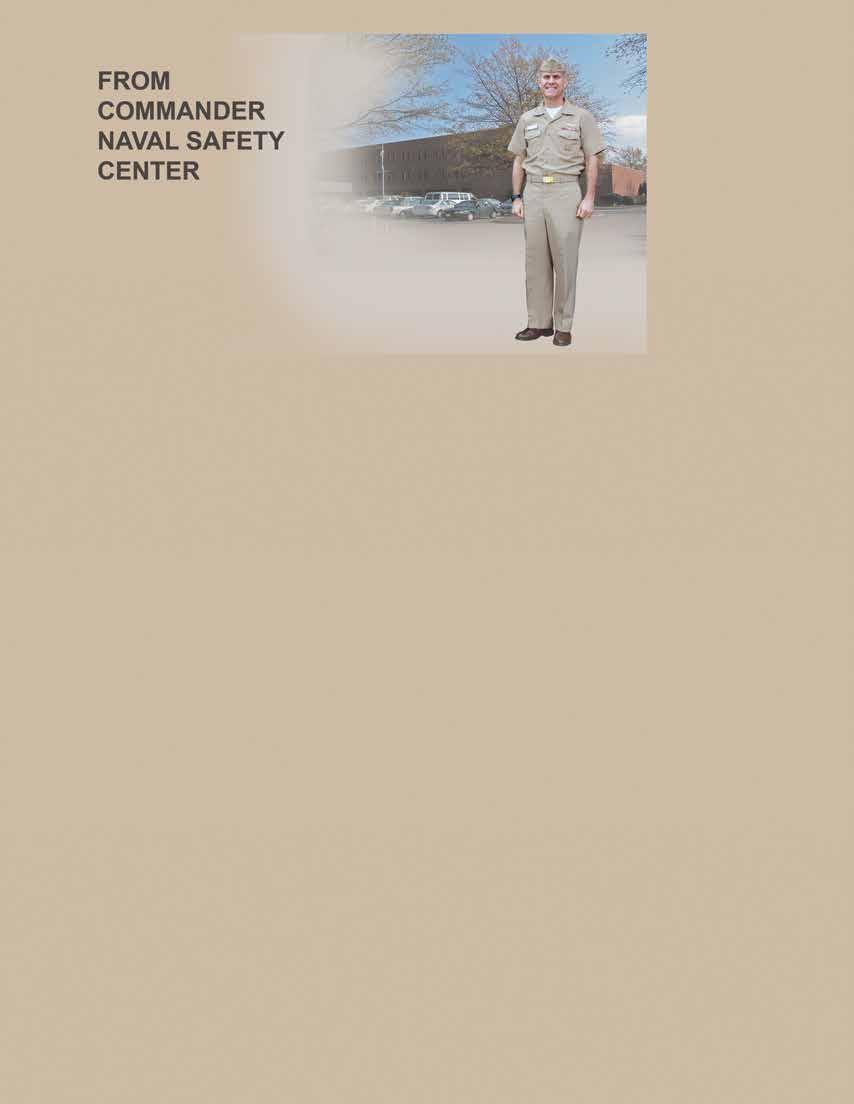
4 minute read
From the Commander
Accomplishing our mission is directly linked to preventing mishaps, as fewer mishaps means we are better optimizing our warfighting capability, allowing us to do what we do best: hone our warfighting edge as we ensure our readiness to respond to crisis.
To improve further, we must continually strengthen our safety mindset. The easy part is setting up safety programs that establish rules, SOPs and by-the-book requirements. They are an important part of a sound safety culture, but there is more to do. Increasingly we must focus on the human factors that cause us to lose focus, often only for a few seconds, leading to disastrous consequences.
The “human factors enemies” are all too familiar to us: complacency, fatigue, not following procedures, lack of crew coordination, actual or perceived pressure, and transition from a positive “can do” attitude to a negative “will do at any cost” attitude. Fortunately we have a wide array of tools designed to address these human shortcomings by ensuring individual excellence and forceful backup of the team: ORM, Human Factors Councils, Maintenance Risk Management (MRM), tool control, FOD walkdowns and professional certifications like CDI and CDQAR. But unless we have a culture in which maintainers refuse to believe there are times when we are too busy to apply these tools, we set ourselves up for an opportunity for gaps in our culture to greatly increase the risk of bad outcomes.
To ensure that the safety culture in your organization is able to withstand pressures to cut corners or put off the Safety Council meeting until next month, ask yourself if the following “building blocks” are firmly in place. First, is everyone fully capable to do their job? Do they know their safety fundamentals and technical procedures cold? Second, do they understand all hands are expected to be an active part of the command’s safety program? Third, has leadership made it absolutely clear that everyone is empowered to stop an evolution, or let someone know they are violating established procedures, even if they must point this out to their seniors?
The most junior person with the least experience can be the only one in the right place to prevent a mishap. Will a clear understanding of procedures, a strong sense of what is expected and command empowerment cause them to speak up without delay, or will they hesitate at a crucial moment? If your command claims ownership of these traits, chances are you are on track. When commands get off-track we pay a heavy price. Recently we lost a helicopter due to poor communication, insufficient risk management and “will do” thinking when a heavy-lift evolution was attempted clearly outside the safe envelope. Several people should have assessed the risks more thoroughly and made sure all were on the same page. As you read Mech, the concept of risk management appears in almost every article. Whether the story is from an airman aboard a CVN or the Maintenance Officer of an HSC squadron, the authors are aware of the importance of risk assessment in making good decisions. I urge you to read each article with a critical eye and look for how these articles reflect risk management successfully embedded in our culture. Chances are that in commands with a mature safety culture, risk management transitioned from a “program” to “instinctive collaborative behavior” a long time ago, and is now deeply embedded in their organizational DNA.
Of course naval aviation operates in an environment where decisions must often be made with split-second timing, thus the need for Time Critical Risk Management (TCRM). We must be prepared to react to unplanned (but not unforeseen) circumstances that greatly alter our risk. This flavor of ORM is remembered by a simple ABCD mnemonic: Assess, Balance Resources, Communicate, and Do/ Debrief. The best approach to TCRM is being fully prepared to execute procedures and take prudent precautions for environments that increase the likelihood of risks raising their ugly heads.
Every maintainer must strive to be completely in sync and communicating so that procedures to adapt to the “unexpected” are executed without confusion or delay. This issue contains several underway examples where young airmen didn’t follow the publications and checklists or recognize the hazards, resulting in the evolution going down the wrong road. What tools to combat complacency should have been used to greater effect in these cases?
When it comes to combating the human factors that are all too prevalent in naval aviation mishaps, the Naval Safety Center is one part of the safety team I encourage you to tap into, in addition to the many other tools available. To continue to build upon our safety record, our task is to make the most of the resources we have, which means making sure everyone is actively engaged on the team. And remember, this concept of optimizing readiness by minimizing losses is equally important off duty, where we lose many more Sailors and Marines than in on-duty mishaps.
RADM Brian Prindle











